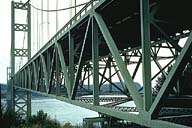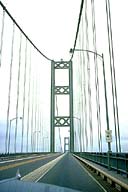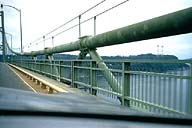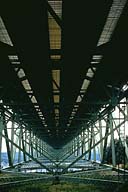
|
Image-GoddenC45
New Tacoma Narrows suspension bridge. The earlier bridge with a center span of 2800 ft. suffered an aerodynamic failure in 1940. The new design, with the same center span, opened in 1950, and incorporates many design changes to prevent such a failure, including those shown in GoddenC45-C48. A deep stiffening truss is used rather than a shallow solid-web girder. (Washington State)
|
|

|
Image-GoddenC46
Tacoma Narrows Bridge. Continuous grillage vents are used over the length of the roadway to prevent development of differential air pressure between upper and lower surfaces of the road deck. This view, taken driving over the bridge, shows the vents as continuous yellow lines. (See also GoddenC45, C47-48 ) (Washington State)
|
|

|
Image-GoddenC47
Tacoma Narrows Bridge. Triangular truss-type shear connectors are used between the cables and the main truss at mid-span to inhibit anti-symmetric torsional displacements: The previous bridge failed in torsional oscillation. (See also GoddenC45-46, C48) (Washington State)
|
|

|
Image-GoddenC48
Tacoma Narrows Bridge. A stiffening truss is used with great stiffness in vertical and horizontal bending and in torsion. The truss is, in effect, a box section with shear stiffening on all four sides for torsional stiffness. The previous bridge had a through plate-girder section with much greater flexibility in bending and torsion. View taken through the truss from underneath the road. (See also GoddenC45-C47) (Washington State)
|
|






